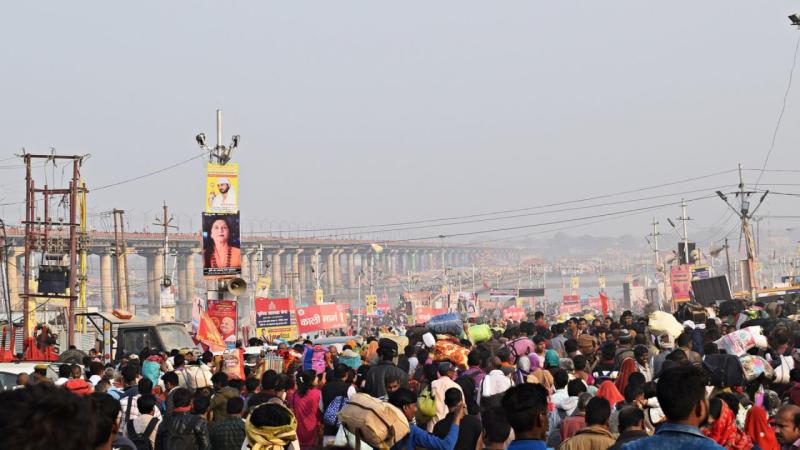
Researchers investigate what factors drive migration in South Asia and its benefits in adapting to climate change.
South Asia, home to the majestic Himalayan mountains and many magnificent rivers, is today battered due to the changing climate. Instances of floods, droughts, cyclones, and irregular rainfall have increased, leaving people in these regions at the mercy of nature. In the deltas, semi-arid plains and the glacial river basins, life is precarious, and people seek out various strategies in the hope of hanging on to dear life.
“People move in search of better employment opportunities, for marriage, away from conflict, and to meet aspirations,” says Dr Chandni Singh, a researcher from the Indian Institute for Human Settlements, Bengaluru.
However, in areas vulnerable to climate change impacts, also called climate hotspots, people have chosen migration as a strategy to survive and adapt to the vagaries of the climate, finds a new study by a team of international researchers, including Dr Singh.
The study, published in the journal Current Climate Change Reports, investigates who migrates, where to, why and what benefits does migration offer for people from the climate hotspots of South Asia. It distils the findings of four consortia that looked at the relationship between migration patterns and how migration could serve as a strategy to adapt to climate change. The study was part of the Collaborative Adaptation Research Initiative in Africa and Asia (CARIAA) initiative.
The four consortia included ASSAR (Adaptation at Scale in Semi-Arid Regions), which studied the rural-urban continuum in Karnataka, DECCMA (Deltas, Vulnerability and Climate Change: Migration and Adaptation) that investigated the Ganges-Brahmaputra-Meghna river delta in Bangladesh and India and the Mahanadi delta in India, HI-AWARE (Himalayan Adaptation, Water and Resilience), which studied various river basins in Nepal, Bangladesh, India and Pakistan, and PRISE (Pathways to Resilience in Semi-Arid Economies) that focused on the semi-arid plains of Pakistan.
“Our objective was to see some trends on who migrates, why, where and how it impacts the migrant household’s capacity to adapt to climate change impacts,” says Dr Amina Maharjan, the corresponding author of the report.
She is a researcher at the International Centre for Integrated Mountain Development (ICIMOD), Nepal.
“Each consortium looked at migration and adaptation but from a different lens, including household adaptation capacity, overall livelihood resilience and subjective well-being,” she explains.
The study collected migration-related data of about 10,000 households through surveys conducted between January 2016 and September 2017 in the four study areas.
Migration as a strategy to cope with climate change
Previous studies suggest that economic factors drive a majority of migration worldwide. In this study, the researchers have focused on labour migration, where one or more members of a family migrate, leaving the other behind. They found that in the study areas, economic reasons were the primary driver of migration, and people moved in pursuit of making money, rather than escape the risks of climate-related events.
“But, adverse impacts of climate change exacerbate existing economic hardship,” says Dr Maharjan, and Dr Singh shares the example of her study from Gulbarga to support this. “In Gulbarga, Karnataka, seasonal migration has been a regular feature. However, increasing rainfall variability is necessitating migration for longer periods, often into precarious jobs,” she says.
The study found that migration is mostly male-dominated with married, young men in their twenties making a move. Most migration was internal, where people migrated within the country, and India tops this list with 37% of the total population being internal migrants. However, international migration was high in parts of Nepal, deltas of Bangladesh and plains of Pakistan, where people moved to oil-rich Gulf countries and Malaysia. Most migrants worked in informal sectors, usually hired as daily wage labourers in industries such as construction or small-scale retail and hospitality.
In return, households with migrants benefited financially. The study found that the average annual remittances from internal migration were about USD 543, while those recorded for international migration was USD 1703. Most households used the money as a buffer against economic losses and to pay for household expenses, and not so much as an investment to acquire an asset. Migration also had social consequences; people who moved out returned with new ideas, knowledge, skills and technologies, which could help them to diversify their livelihoods.
The study found that migrant households, in general, are better capable of adapting to impacts of climate change.
“However, the outcome is dependent on who migrates, what skill they possess, the purpose of the move and other factors,” says Dr Maharjan.
While migration can lead to lesser risk in climate hotspots, higher incomes, better purchasing power and higher material well-being, there are downsides too. Migrants often have severed social and familial ties, and end up with unsafe jobs like construction labour.
“Sometimes, they face new risks of living in informal settlements in big cities that do not have adequate infrastructure,” says Dr Singh.
In India, studies on migration focus on examining economic outcomes, which only tell a part of the story. The current study, which relies on life-history interviews to investigate how migration impacts livelihoods, stands out in that sense.
“Our study tells a very different story of migration and adaptation as compared to static survey-based studies,” says Dr Singh. “Migration decision is a complex interplay of climatic and non-climatic drivers and understanding these complexities needs nuanced methodologies,” she argues, citing interesting implications of migration on women and men.
The need for a safety net for migrants
The numbers from the Census of India states that out of about 98 million migrants in the country, 61 million moved to rural areas and 36 million to urban areas. The states of Uttar Pradesh and Bihar had the most significant number of migrants migrating out. While most women cited marriage as the reason for migration, employment and education were primary drivers for men. However, with increasing adversities of climate change, these numbers are expected to surge, especially in climate hotspots.
Unfortunately, there is increasing hostility towards migrants in South Asia, internally and internationally. India, for example, has brought in controversial legislation intending to weed out illegal international migrants. In the last decade, unrest against migrants in the states of Manipur, Assam, Gujarat, Maharashtra, Karnataka and others have increased. While migration is only going to be exacerbated, what can the governments do to ensure the safety of these vulnerable people?
“It is vital that the government recognises migration as a strategy adopted by people from vulnerable areas to deal with the increased climatic risks,” says Dr Maharjan.
Since most migrants arrive at industrial and service-driven urban centres, there will be an increase in the need for infrastructure and services in these areas. “Governments should prepare to strengthen and develop policies to accommodate potential flows of migrants, particularly after sudden-onset events such as cyclones and extreme surges,” she adds.
Dr Singh urges that governments should provide social safety nets for migrants by facilitating portability of identification documents and providing crèches for children of migrants. Besides, improving rural livelihoods by making farming and allied sectors remunerative and attractive can also cut back on migration.
“There is also a need for policies and institutions to bridge the rural-urban divide and recognise the lack of attention to peri-urban areas,” she suggests.
The Intergovernmental Panel on Climate Change (IPCC) projects that South Asia would face more prolonged droughts, hotter summers and winters, and growing water insecurity by 2050. “All these will shape migration patterns,” cautions Dr Singh, who is an author on this report.
“Are our cities up to the task of absorbing people and providing basic services to them? As India urbanises, how are we going to ensure urban sustainability? These are questions integral to India’s development story,” she signs off.






